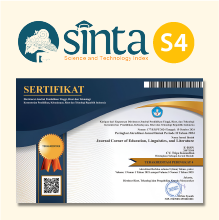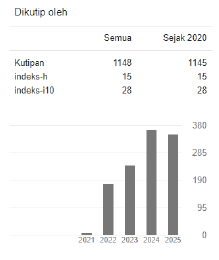Error Analysis in Students English Speech of Public Speaking
 https://doi.org/10.54012/jcell.v4i001.372
https://doi.org/10.54012/jcell.v4i001.372
 Abstract views: 431
Abstract views: 431
 PDF downloads: 285
PDF downloads: 285
Keywords:
Error Analysis, English Speech, kind of error, cause of error and the influence of errorAbstract
This study aimed to analyze the kind of error in English speech of public speaking, to identify the cause of error in English speech of public speaking, and to identify the impact of error in English speech of public speaking. This research conducted in public speaking class of Ushuluddin Boarding School South of Lampung. This research employed a qualitative approach and used content analysis as the method of study. A data of the research was 15 documentation record of student’s English speech. To find out the error in students English speech of public speaking, the surface structure taxonomy was used for analyzing of phonology error, and the linguistic category classification and the surface structure taxonomy were used for analyzing of morphology and syntax error. The findings show; (1) the kinds of error in phonology were 156 substitution errors, 136 omission errors and 57 addition errors. Therefore the most dominant error in phonology was substitution error of vowel (102). The total of number errors in morphology and syntax were 169 errors, and the most dominant error in morphology and syntax was diction errors (50). The kinds of error in morphology and syntax were 83 misformation errors, 46 misordering errors, 33 omission errors and 7 addition errors. (2) The cause of error in phonology, morphology and syntax was intra language. Intra language is the error made by the learners in learning English. (3) There are found two impacts of errors in student’s speech; 1) an error in phonology called global error. Global error is makes an utterance difficult to understand. 2) An error in morphology and syntax called local error. Local error is not influence a message of the speech
Downloads
References
Abuhussein, H. F., Qassrawi, R. M., & Shaath, S. (2023). Utilizing remote speaking tasks for tackling foreign language anxiety. Cogent Education, 10(2). https://doi.org/10.1080/2331186X.2023.2238150
Burhanuddin, A. (2020). Error analysis of English sentences written by Indonesian college students. Jurnal Lingua Idea, 11(1), 30–43.
Ebadi, S., & Asakereh, A. (2017). Developing EFL learners’ speaking skills through dynamic assessment: A case of a beginner and an advanced learner. Cogent Education, 4(1). https://doi.org/10.1080/2331186X.2017.1419796
Elmiyati, E. (2019). Improving Students Speaking Ability Through Debate in The Classroom ( A Case Study for Students at Second Years Students’s of SMAN 3 Kota Bima in Academic Year 2017/2018). International Journal of Multicultural and Multireligious Understanding, 6(1), 229. https://doi.org/10.18415/ijmmu.v6i1.561
Fadillah, A. C. (2020). Pronunciation difficulties of EFL learners in Indonesia: a literature study. Jurnal Budaya, 2(1), 7–13.
Getie, A. S. (2020). Factors affecting the attitudes of students towards learning English as a foreign language. Cogent Education, 7(1). https://doi.org/10.1080/2331186X.2020.1738184
Iberri-Shea, G. (2017). Adaptation and assessment of a public speaking rating scale. Cogent Education, 4(1). https://doi.org/10.1080/2331186X.2017.1287390
Khan, A. (2022). The effect of writing exercises in classroom on the production of written sentences at undergraduate level by Saudi EFL learners: A case study of error analysis. Cogent Education, 9(1). https://doi.org/10.1080/2331186X.2022.2122259
Mariana, I., Purnomo, S., & Firdaus, A. R. (2018). Improving Student Writing Skills in Indonesian Language Learning Narrative Writing Materials Using Writing Process Approach. COLLASE (Creative of Learning Students Elementary Education), 1(3), 99. https://doi.org/10.22460/collase.v1i3.2273
Musetiarini, M. (2020). English Public Speaking Programmes at Islamic Boarding House of Matlabus Salik Nganjuk (A Case Study Of Female Students). IAIN PONOROGO.
Prayuda, M. S., Juliana, J., Ambarwati, N. F., Ginting, F. Y. A., & Gultom, C. R. (2023). Students’ Writing Error in Parts of Speech: A Case Study of EFL Students. Jurnal Educatio FKIP UNMA, 9(2), 659–665.
Rianto, A. (2021). Examining gender differences in reading strategies, reading skills, and English proficiency of EFL University students. Cogent Education, 8(1). https://doi.org/10.1080/2331186X.2021.1993531
Riasati, M. J. (2018). Willingness to speak English among foreign language learners: A causal model. Cogent Education, 5(1), 1–17. https://doi.org/10.1080/2331186X.2018.1455332
Sayogie, F., & Adbaka, M. F. (2022). Interlingual Errors in Indonesian EFL learners’ Pronunciation: From Minimal Pairs to Speaking Ability. Elsya: Journal of English Language Studies, 4(2), 131–146.
Downloads
Published
How to Cite
Issue
Section
License
Copyright (c) 2024 Neni Desi Fajarwati

This work is licensed under a Creative Commons Attribution-ShareAlike 4.0 International License.
All articles published in the Journal Corner of Education, Linguistics, and Literature are licensed under the Creative Commons Attribution-ShareAlike License (CC BY-SA).

















